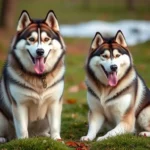
Introduction
Dog breeds play a significant role in human companionship, offering diverse characteristics, temperaments, and abilities suited to various lifestyles. Among these breeds is the Stephens Cur, a lesser-known but remarkable dog with a fascinating history and a unique place in the hearts of many dog lovers. Understanding different dog breeds, including the Stephens Cur, is essential for potential pet owners, as it helps them make informed choices about which dogs align best with their lifestyles and preferences.
Understanding Dog Breeds
Definition of Dog Breeds
A dog breed is a specific group of domestic dogs with particular characteristics that distinguish them from others. These traits can encompass physical appearance, behavior, and temperament, all of which are often the result of selective breeding. The classification of dog breeds is vital in understanding canine genetics and behavior, as it helps predict how a dog might behave or what health issues it may face.
Factors Influencing Dog Breeds
Several factors influence the development and classification of dog breeds:
- Genetic Traits and Selective Breeding: Breeders select dogs with desirable traits, leading to the establishment of distinct breeds with specific characteristics.
- Environmental Influences and Adaptation: Dogs often adapt to their environments, which can influence their behavior and physical traits.
- Role of Breed Standards: Breed standards, defined by kennel clubs and organizations, help maintain breed integrity and are crucial for dog shows and competitions.
Overview of the Stephens Cur
History of the Stephens Cur
The Stephens Cur is an American breed that originated in the early 20th century in the southeastern United States. It was developed by a man named W.T. Stephens, who aimed to create a versatile hunting dog proficient in treeing game. The Stephens Cur played a vital role in hunting and farm work, showcasing its skills in tracking and retrieving. Over time, this breed gained recognition for its abilities and became a favorite among hunters and outdoor enthusiasts, although it remains relatively lesser-known compared to more popular breeds.
Physical Characteristics
The Stephens Cur is a medium-sized dog, typically weighing between 30 to 50 pounds and standing about 18 to 24 inches tall at the shoulder. Their athletic build reflects their energetic nature and endurance.
- Coat Types and Colors: The coat of the Stephens Cur is short and dense, providing protection from various weather conditions. Common colors include brindle, black, and tan, often with white markings.
- Distinguishing Features: One of the breed’s most notable features is its expressive eyes, which convey intelligence and alertness.
Temperament and Behavior
The Stephens Cur is known for its friendly and loyal temperament. These dogs are highly intelligent and trainable, making them excellent companions for both active families and individuals.
- Personality Traits: They are energetic, playful, and eager to please, often forming strong bonds with their human families.
- Interaction with Children and Other Pets: The Stephens Cur is generally good with children and can coexist well with other pets, especially when socialized from a young age.
Care and Maintenance
Nutrition Requirements
Feeding a Stephens Cur requires attention to its nutritional needs to ensure optimal health. A balanced diet consisting of high-quality dog food that meets their energy demands is essential.
- Common Dietary Concerns: Some Stephens Curs may be prone to food allergies or sensitivities, so it’s crucial to monitor their reactions to certain ingredients.
Exercise Needs
Due to their energetic nature, Stephens Curs require regular exercise to maintain their physical and mental health. Daily exercise should include:
- Long walks or jogs
- Playtime in a secure, fenced area
- Activities like fetch or agility training to keep them engaged
Grooming Essentials
Maintaining a Stephens Cur‘s coat is relatively straightforward, thanks to its short hair. Regular grooming routines should include:
- Weekly brushing to remove loose hair and dirt
- Occasional baths as needed to keep them clean and fresh
- Regular check-ups of their ears and nails to ensure overall hygiene
Health Considerations
Common Health Issues
Like all breeds, the Stephens Cur may face certain health challenges. While generally robust, potential breed-specific issues include hip dysplasia and eye conditions. Regular veterinary check-ups can help catch any health problems early.
Lifespan
The average lifespan of a Stephens Cur ranges from 12 to 15 years. Factors influencing their longevity include genetics, diet, exercise, and overall care. Providing a loving environment and routine veterinary care can significantly enhance their quality of life.
Training and Socialization
Basic Training Tips
Training a Stephens Cur can be a rewarding experience due to their eagerness to learn. Effective training techniques include:
- Positive Reinforcement: Using treats and praise to encourage desired behaviors.
- Consistency: Establishing clear commands and expectations to avoid confusion.
Behavioral Challenges
While Stephens Curs are generally well-behaved, they can exhibit certain behavioral challenges, such as stubbornness or excessive energy. Addressing these issues may require:
- Engaging in regular training sessions
- Providing ample exercise to curb excess energy
- Seeking professional help if behavioral issues persist
Choosing a Stephens Cur
Finding a Reputable Breeder
When considering bringing a Stephens Cur into your home, locating a responsible breeder is essential. Look for breeders who:
- Are involved in breed clubs and organizations
- Provide health clearances for their breeding stock
- Are willing to answer questions and allow you to meet the puppies’ parents
Adoption Options
Adopting a Stephens Cur from shelters or rescue organizations can be a fulfilling option. Benefits of adoption include:
- Giving a dog a second chance at life
- Often lower costs compared to buying from breeders
- The joy of providing a loving home to a dog in need
Preparing for a new dog involves gathering necessary supplies, such as food, toys, and a comfortable bed, and ensuring that your living space is safe and welcoming.
Conclusion
In summary, the Stephens Cur is a unique and versatile breed with a rich history and endearing traits that make it an excellent companion for many households. By understanding the characteristics, care requirements, and training needs of this breed, potential dog owners can make informed decisions about whether a Stephens Cur is the right fit for them. The joys of dog ownership extend beyond companionship; they encompass the love, loyalty, and happiness that these remarkable dogs bring into our lives.
By considering the Stephens Cur and its admirable qualities, you may find the perfect addition to your family, one that embodies the spirit of companionship and joy that every dog owner cherishes.









